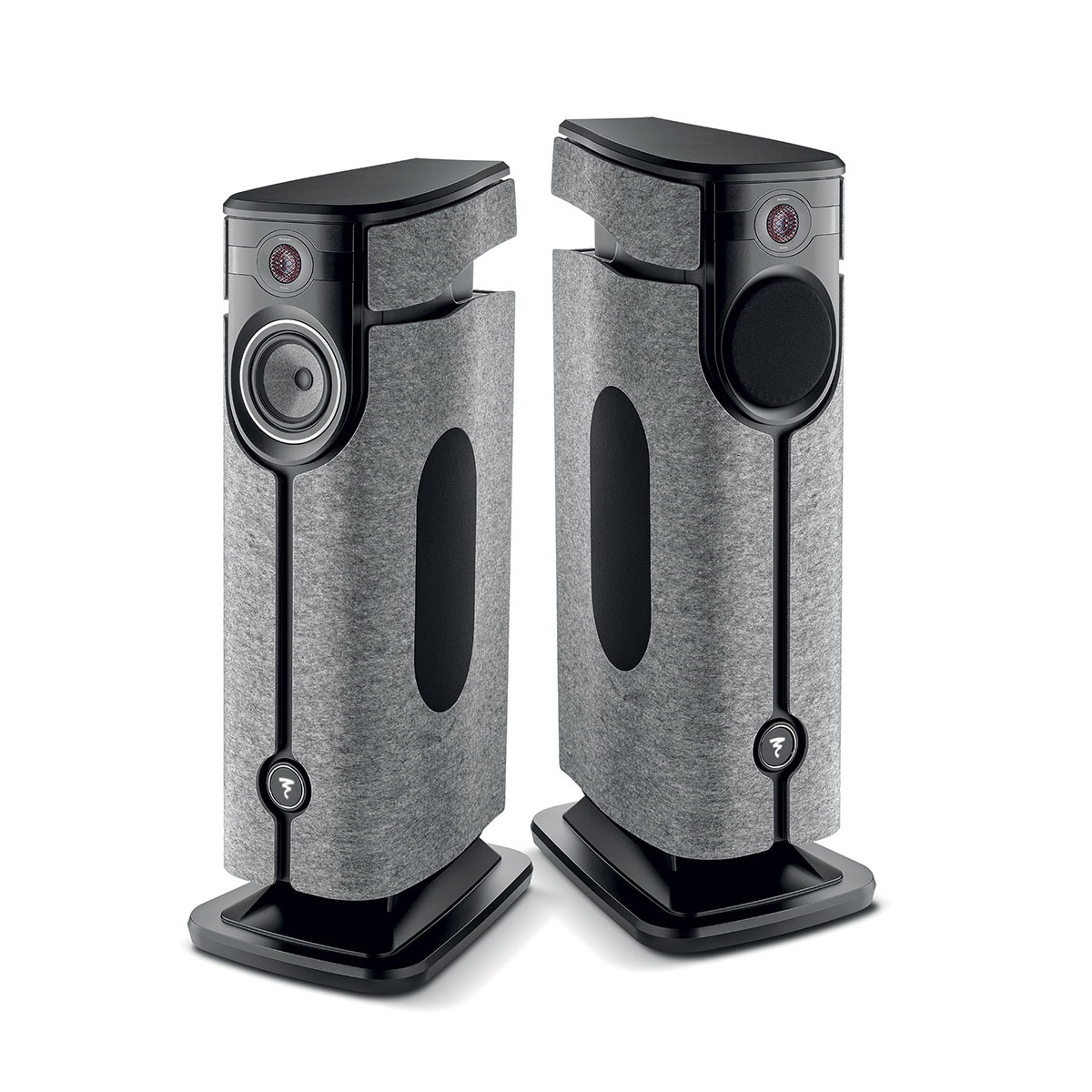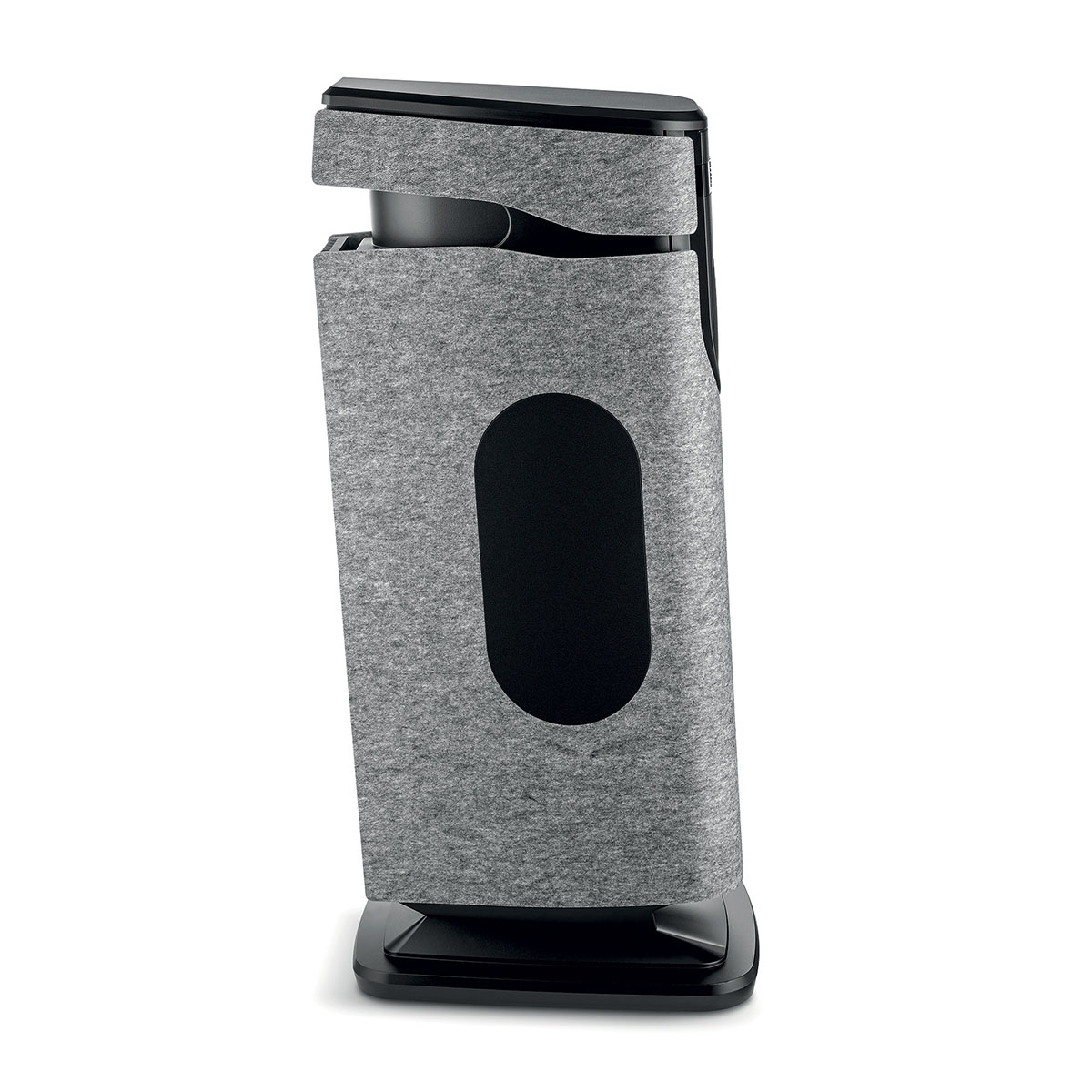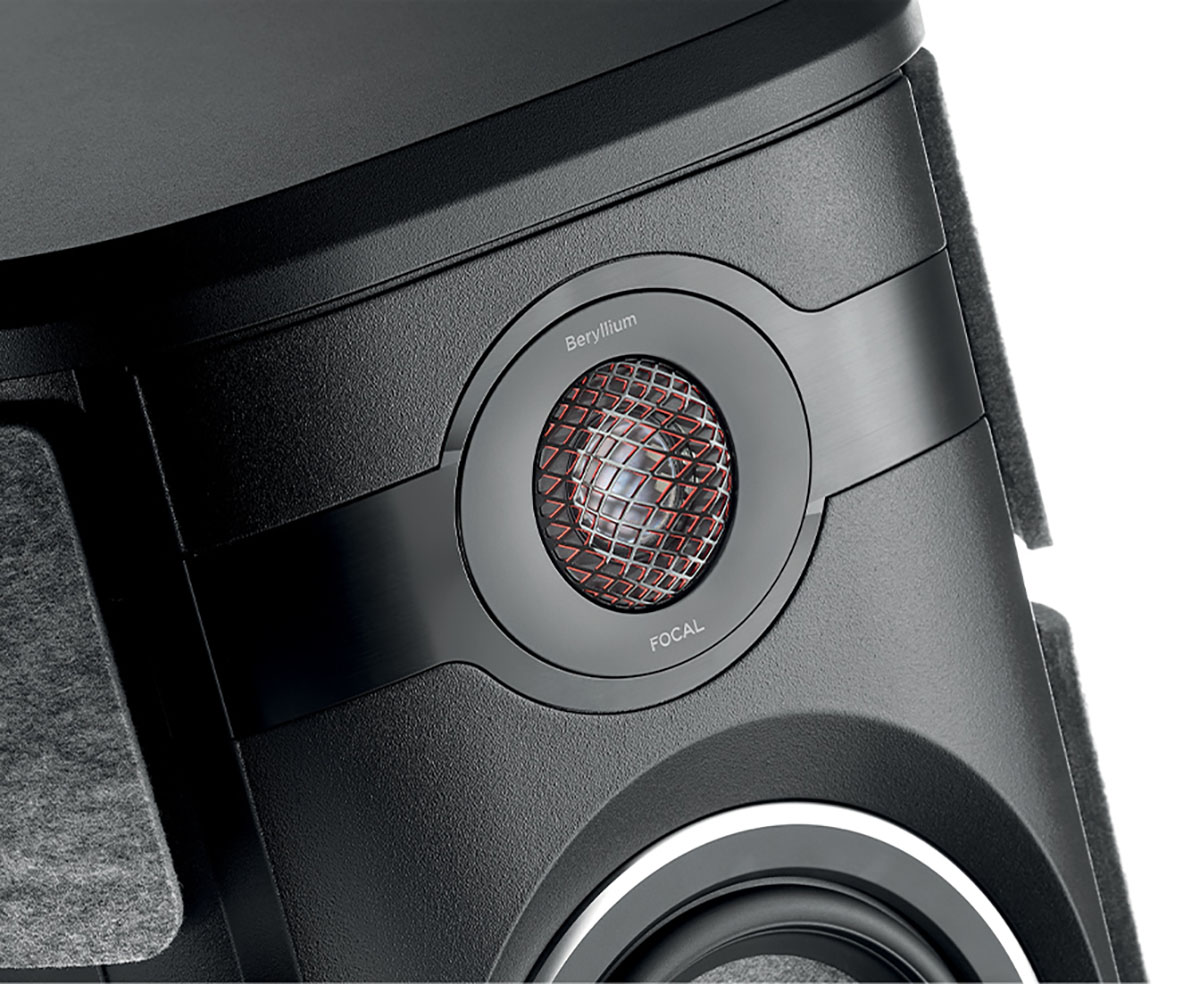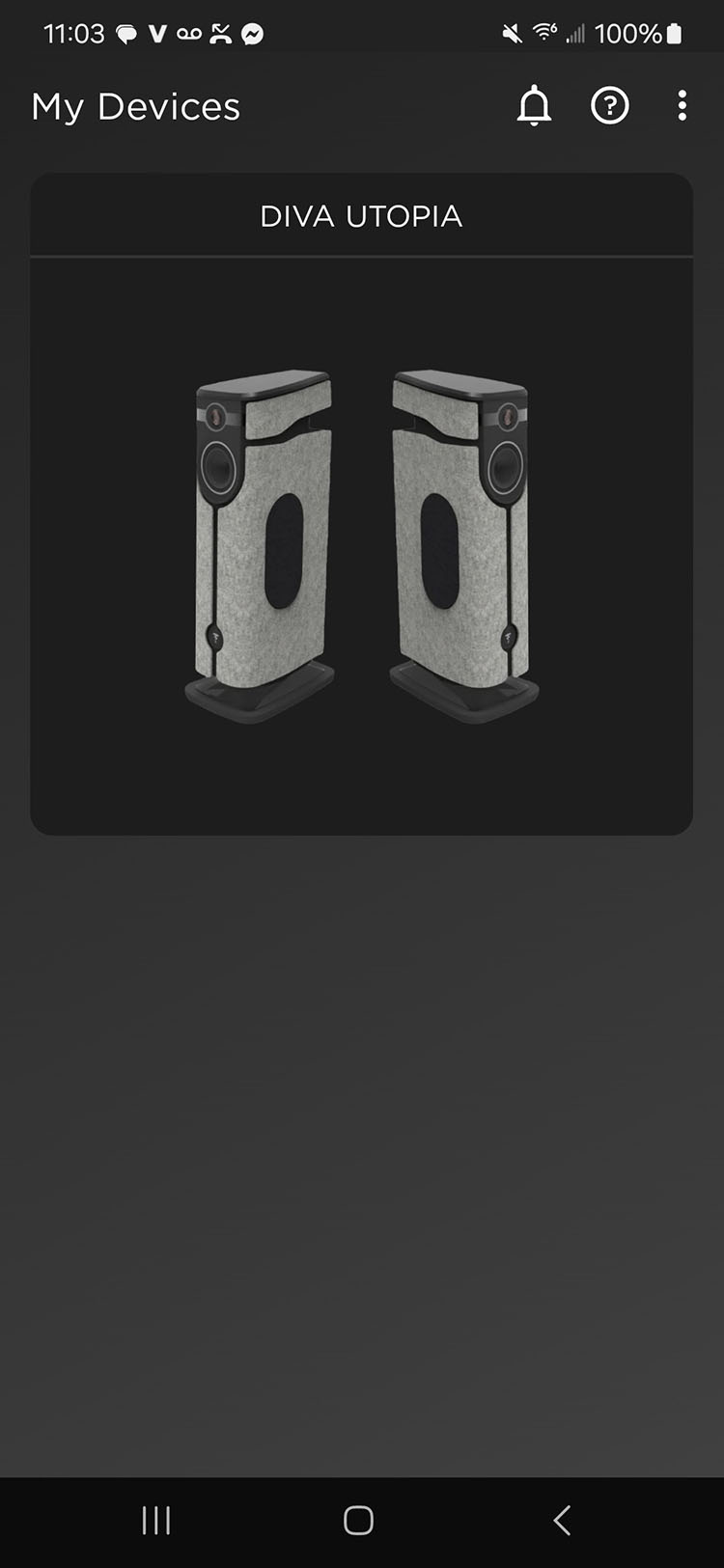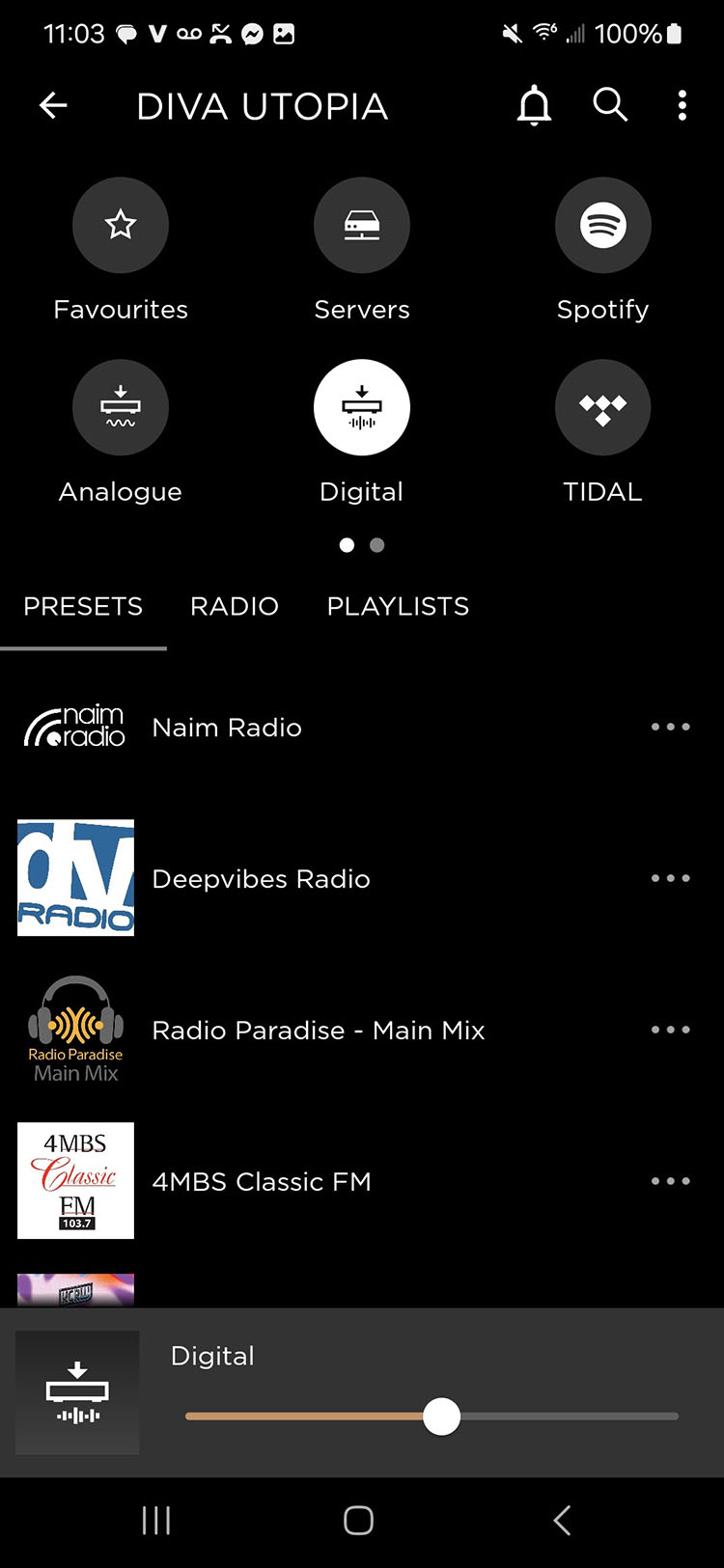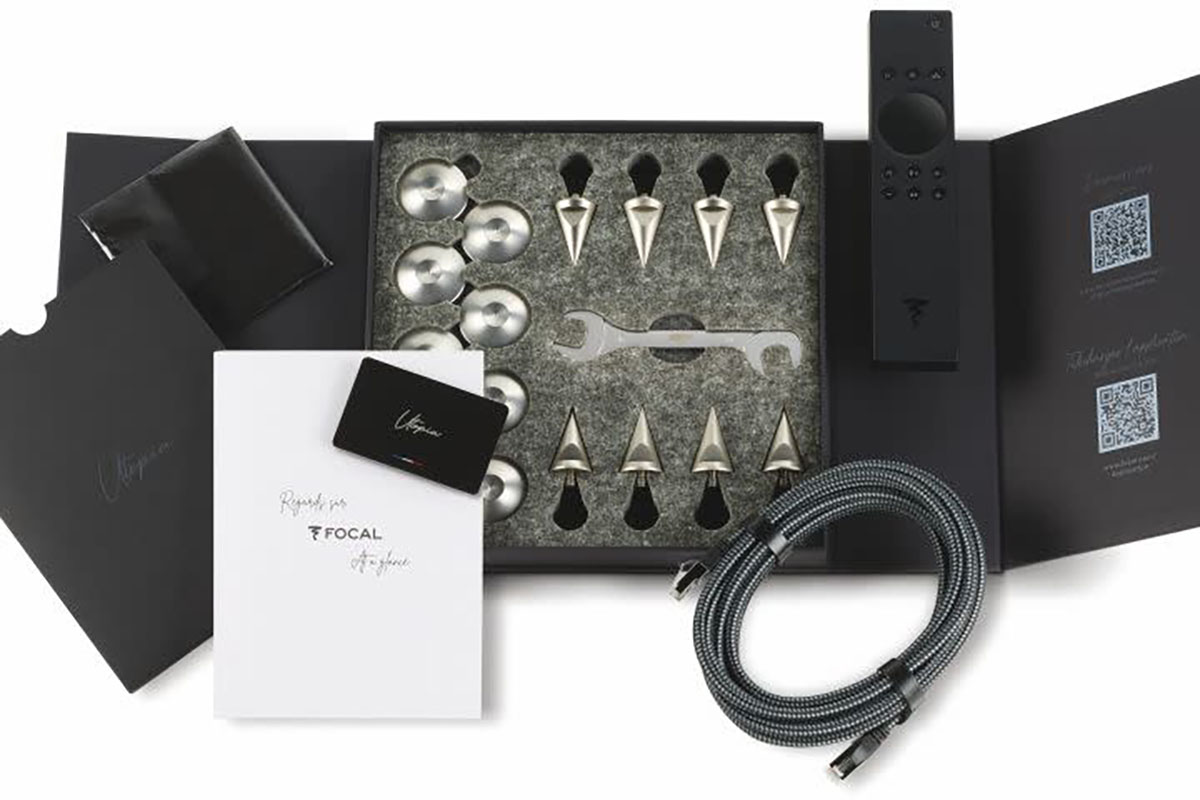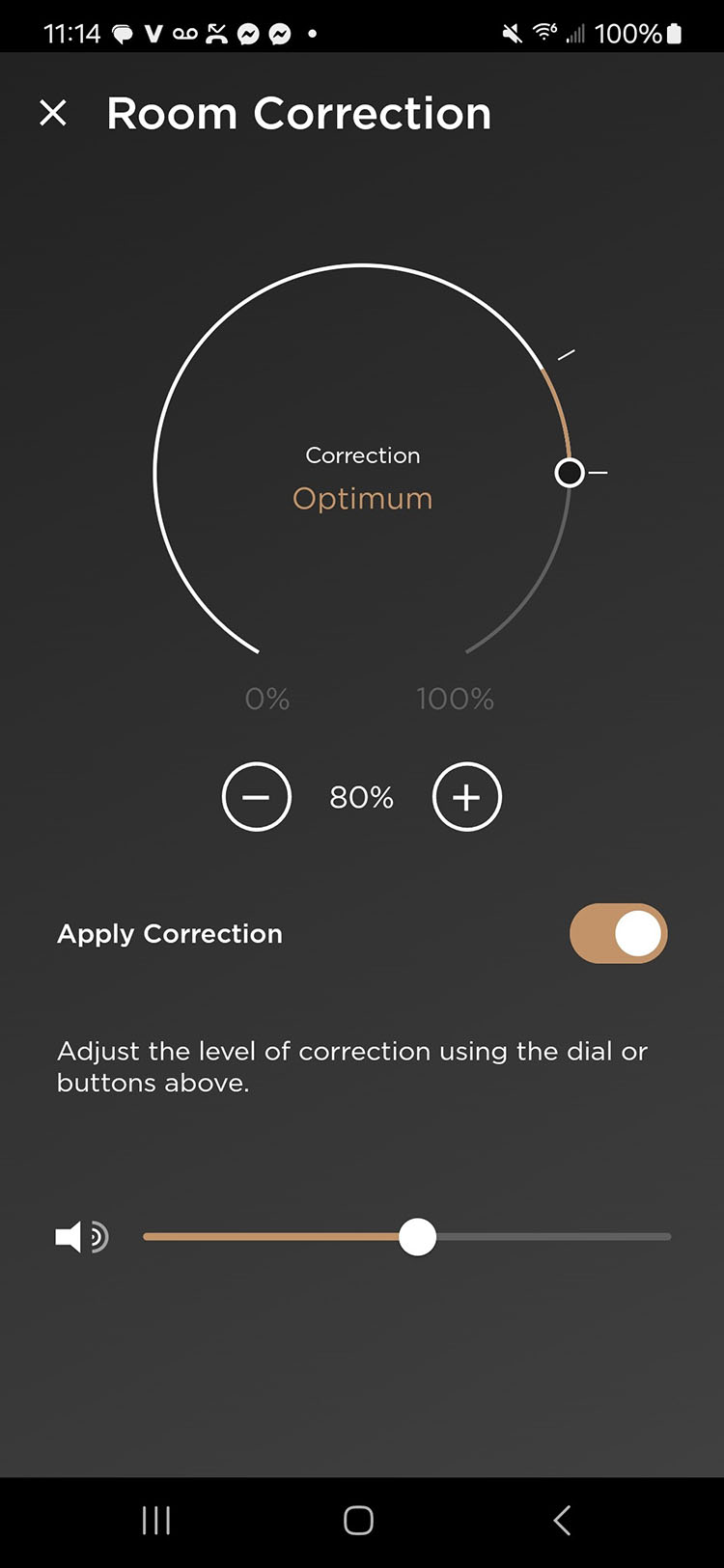Their domestic speaker models today span from affordable speakers for less than $2,000 per pair to all-out assaults on the state of the art for around $280,000 per pair. Focal is also renowned for their headphones and is a major force in the personal audio business. The Focal Diva Utopia is a new direction for the company: a full-range speaker which combines built-in amplifiers and a streamer from partner Naim Electronics in a reasonably compact enclosure that sells for a turnkey price of $40,000 per pair in US Dollars.
This DIVA system from Focal is based on what the company refers to as a ‘connected’ loudspeaker package. We are going to go in deep, uncovering all the technology that Focal jammed into these four- foot-tall towers, which is a daunting task in itself. This system is so complete that all one needs is a smartphone or a tablet along with a few minutes to set it up, and one can experience glorious sound from a variety of music sources.
Focal Diva Utopia Connected Loudspeaker System
- Focal exclusive “W” membrane 6.5-inch woofers (4).
- One “W” membrane 6.5-inch bass-midrange driver.
- TMD suspension for stabilized surround.
- Focal “M” profile 27 mm Beryllium tweeter.
- Infinite Acoustic Loading for the tweeter.
- Naim amplification @ 250 watts for the woofers and 75 watts each for the bass-midrange and tweeter drivers.
- Fully DSP-controlled crossover.
- Excellent App for Plug-and-Play ease of use.
- Compatible with Google Assistant and Siri.
- Studio-grade sound at 192 kHz/24 bits from wireless sources (exceeds CD standards).
- A true full-range speaker with deep bass to 20 Hz.
- Multiple inputs for both music and movie experiences.
- App-controlled room correction.
- No need to purchase multiple cables.
- Detailed sound in a holistic operating system.
- Every audiophile needs to hear what this system can do!
Historically, Britain and France have had a somewhat adversarial relationship on many issues. 32 major military campaigns between the 12th and 19th centuries kind of attest to the fact they weren’t exactly “buddy-buddy” for the longest time. Fast forward to today, and things are much friendlier and cooperative between the two. Case in point, we have Naim of British fame teaming up with Focal of French lore to bring us both peace and a sublime audio experience in the form of the Diva Utopia connected loudspeaker system. The Diva Utopia concept goes beyond mere active loudspeaker technology into the realm of simplicity that we ultimately found was more than the sum of its parts would suggest.
The Focal Diva Utopia is close to being a revolution in speaker design and functionality. It is an exceedingly complex system that marries extremely high-quality loudspeaker drivers directly to a dedicated amplifier while eschewing the usual loudspeaker crossover. Despite the complexity of the internals of the Diva Utopia’s operating system, it is designed to be a relatively simple system for the music lover who wants the best sound possible without a lot of fuss. We are going to explore what, if any, compromises had to be made to bring the Divas to market.
Type:
3-way bass-reflex active speaker system.
Bass Drivers:
Four x ‘W’ 6 1/2″ (16.5cm) in a push-push configuration.
Bass-Midrange Driver:
Single W’ 6 1/2″ (16.5cm) with TMD surround and NIC motor.
Tweeter Driver:
Single IAL2 1 5/8″ (27mm) pure beryllium ‘M’-shaped inverted dome.
Bandwidth:
(+/-3dB) 27 Hz-40 kHz
Low-frequency cut-off:
(-6dB) 24 Hz
Maximum volume (per pair):
116dB SPL (@ 1m)
Amplification power per loudspeaker:
LF: 250W Class AB – MF: 75W Class AB – HF: 75W Class AB
Power supply:
110-120V/220-240V ~50/60Hz
Power consumption / Usage type:
280W
Network standby mode:
<2W
No-network standby mode:
<0.5W
Inputs for Primary loudspeaker:
HDMI eARC, CEC
TOSLINK Optical
RCA analogue
Type A USB 2.0
RJ45 Ethernet
RJ45 Speaker Link
Secondary loudspeaker:
RJ45 Speaker Link
Internet radio formats:
Windows Media-formatted content, MP3, ACC, Ogg Vorbis streams, and MMS
Audio format:
WAV, FLAC and AIFF – up to 24bits/384kHz
ALAC (Apple Lossless Audio Codec) – up to 24bits/384kHz
MP3 – up to 48kHz/ 320kbits (16bits)
AAC – up to 48kHz/320kbits (16bits)
OGG and AAC – up to 48kHz (16 bits)
DSD64 and DSD128
Bluetooth® – aptX™ Adaptive, SBC, AAC
Note: Handles smooth, continuous playback on all formats.
Multiroom Sync up to 32 Focal & Naim streaming devices controlled via the Focal & Naim app.
Wireless streaming features:
AirPlay 2
Google Cast
UPnP™
Bluetooth® 5.3
Spotify via Spotify Connect
TIDAL via TIDAL Connect
QQ Music via QPlay
Music streaming services via the Focal & Naim app:
TIDAL
Qobuz
QPlay
Internet radio
Podcasts depend on services available in each country.
Network Ethernet:
(1000/100/10Mbps), Wi-Fi (Wi-Fi 6)
Wireless connection:
UWB 96kHz/24bits
Wired Connection with Hi-Res Link:
192kHz/24bits
Dimensions (H x L x D):
47 5/8” x 16 1⁄2” x 22″ (121 x 42 x 56cm)
Net weight:
141 lbs. (64kg)
MSRP:
$40,000 USD per pair
Website:
Company:
SECRETS Tags:
Focal, Diva, Utopia, Diva Utopia, Connected, Loudspeaker, Loudspeaker System
Secrets Sponsor
The transducers in the Focal Diva Utopia are tasked with taking everything that has occurred upstream and turning the signal into music. With that in mind, we will begin with the 6.5-inch bass-midrange unit that is forward-firing. This unit features the “W” Membrane cone, which is proprietary to Focal and completely designed and built in-house. The “W” Membrane cone is constructed with a central foam body sandwiched between two sheets of glass fiber. The emphasis is on lightness, rigidity, and damping. Focal claims this construction leads to an optimal frequency response curve with high output and low distortion along with strong macro-dynamics while retaining detailed micro-dynamics.
The four 6.5-inch dedicated woofers use the same ‘W’ Membrane construction with the quad pack of woofers yielding comparable surface area to a single 13-inch subwoofer driver with the added benefit of the quickness in the upper bass regions that dividing the bass into four drivers can bring. The ‘push-push’ loading of the four bass drivers into the ground radiation vent (which prevents chuffing during high-level bass events – we never heard any unwanted noises regardless of the level) yields bass below 25 Hz with no external subwoofer needed.
The ‘M’ profile Beryllium Tweeter is the product of two years of research and development at Focal. This project resulted in the shaping of an inverted dome tweeter made from pure Beryllium, capable of covering more than five octaves. The “M” profile claims two other advantages: a reduced directivity of sound and a significant gain in dome rigidity, which further reduces distortion. It is combined with a larger coil (25 mm) for higher power handling. Internal resonances within the tweeter enclosure are minimized through Focal’s infinite acoustic loading system.
The enclosure itself is a high-density molded polymer body with a rounded, rigid, anti-vibration structure designed for high cabinet strength and the perfect place on which to mount the above-mentioned drivers.
Now that we have six drivers in the cabinet, let’s get some power to them. For each speaker, Naim built a 250-watt Class AB power amplifier for the woofer section, a 75-watt Class AB power amplifier for the 6.5-inch bass-midrange, and a 75-watt Class AB power amplifier for the tweeter. Each amplifier is connected directly to its drivers without the need for a passive crossover. This is important to sound quality because all passive crossovers will ‘bleed’ the available power to the driver units. The result of an active crossover is a more dynamic, purer sound. Another benefit to having an active speaker like this is the lack of need for speaker cables, along with the limitations they bring. Every time wires and connectors are added to the mix, resistance to the signal is increased. In the Focal Diva Utopia system, each amplifier only requires a short run of wire to the respective drivers, which minimizes the effects of multiple connections. It also eliminates a lot of expense for the potential purchaser in terms of having to buy speaker cables. The Focal-Naim team has taken advantage of the holistic system approach by optimizing the amplifiers, internal cables, DSP controlled crossover, and the speaker drivers as a complete system that reproduces the state-of-the-art sound as designed by the team. This complete system approach also assures no damage can occur from over-driving the amps or speakers, nor will there be any issues from overheating.
So, we have top shelf amplifiers and tremendous drivers in a robust cabinet and an active configuration, but what about source material? The back panel of the primary speaker offers an RCA input for the dedicated audiophile who might want to plug in a high-end CD player or Phono pre-amplifier. There is also a Toslink Optical cable input and HDMI eARC for easy connection of other digital devices or television viewing with high-end audio. This primary speaker is user-selectable from the app as either the left or right speaker. At the center of all this is the user interface with the Diva Utopia App.
The Diva Utopia App is the hub of the system and is designed for non-computer-wiz music lovers to enjoy a variety of sources at their fingertips. One can select the digital inputs, analog input, and a variety of music stations, including Naim Radio, Deepvibes Radio, Radio Paradise, and others. It also allows easy access to Tidal, Spotify, Qobuz, Internet Radio, and Bluetooth. Those with a CD player and a preference for physical music sources can access the RCA inputs on the back of the right speaker.
Focal claims that the Diva Utopia Connected Loudspeaker System is a turnkey operation. This is a claim that turns out to be more than credible. As we later discovered, the $40,000 entry price covers the cost of everything a smartphone or tablet user needs to put together an ultra-high-end two-channel system for what was ultimately a reasonable investment. They take all the guesswork out of matching components, and they do so in an attractive product that would look at home in the most elegant of domestic environments.
One final note in the design is the thick felt wraparound panels for the enclosure. It is functional due to its ability to make as few reflective surfaces as possible on the front and side baffles. The construction of the Diva Utopia is designed to accommodate different types of finish panels without impacting the sound. Look for different materials besides felt along with additional color schemes to become available in the future.
The Focal Diva Utopia pair arrived via truck on a large pallet. What we experienced next was something most buyers will never have to do, as an audio store selling this $40,000 system will be more than happy to deliver the system and set it up in the purchaser’s home.
I arranged for help in lugging the 180-pound boxes into our listening room and, from there, was able to complete the installation with no outside help. The boxes open from the front, with the speakers standing vertically. The front of the box becomes a ramp down, which the speakers are easily rolled with the factory-installed casters on the speaker’s base. From there, it was a simple task of rolling the speakers into place and starting the syncing process.
This system, as designed by Focal, is brilliant as it will allow the user to make small adjustments in the speaker’s location with ease. Once one finds the ideal location, a bit of tape to mark the spot and installation of the spiked feet (with floor protecting discs at the ready if needed) to complete the physical installation.
After rolling the Divas into our usual speaker position with the rear of the speakers 36 inches from the back wall, 10 feet apart, and 11 feet from the listening position, I wired up the system. This involved plugging the speakers into a Clarus Concerto power conditioner, followed by connecting the two speakers via the supplied RJ45 Speaker Link. One can also connect the two speakers wirelessly through the Wi-Fi system, with a resolution of 96kHz / 24-bit, but the RJ45 link increases the resolution to 192kHz / 24-bit. I opted for the higher resolution provided by the cable for critical listening but did not notice a difference with the wireless option for the audio tracks used for comparing the two. The fact that Focal offers this choice is yet another example of the thoughtfulness of the design in its entirety.
Once all these connections were made, it was a simple task to download the app and get ready for some serious listening. The app was used to set the right speaker as the primary speaker. The app’s functionality is remarkable, as it will allow easy control of several installed radio stations, Spotify, Tidal, and Qobuz. One can also use the app to connect to any of the digital or analog inputs. I ended up using three sources for all auditioning: Qobuz, a Michi Q5 DAC / Transport, and the eARC from a 75-inch Samsung 4K TV for movies.
Having all three readily available from my smartphone made for easy access to all forms of entertainment. I am normally not nearly as fond of apps as my millennial-aged children, but I found the Focal-Naim app to be a real joy to use.
This app is also the controller for the Focal “ADAPT technology: the first room acoustic correction system tailored to each user’s unique auditory perception.” The ADAPT system will be discussed in a separate section as it warrants closer attention.
ADAPT System
The ADAPT system does not function in the same manner as systems from DIRAC or Audyssey. The closest analogy would be a visit to the optometrist during the session in which the doctor flips between two images and asks, “Which looks clearer, this one? … or this one?” The first step is to measure how far the speakers are from the back wall, the side walls, from the listening position, and finally, how far apart they are from each other.
ADAPT will then walk one through two series of a total of 14 different tones. One adjusts the volume until the two tones each time sound equally loud. The tones will be at different frequencies, and each set descends lower into the mid-range until the deepest bass. The system in its entirety is adapting to the listener’s own ears, and it’s quite good in practice. It’s not a huge difference, but ADAPT will help bring out (at least for this reviewer) that final bit of coherence in the sound. The process takes about 15 minutes, including the physical measurements.
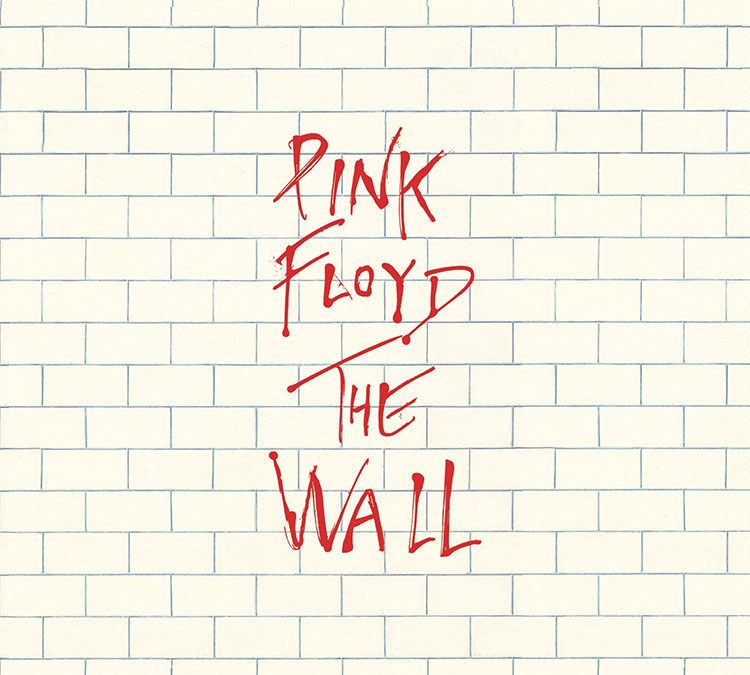
Pink Floyd: The Wall (Qobuz)
‘The Wall’ has been a staple for auditioning loudspeakers for over 45 years, and with good reason. It has an excellent bass track, powerful dynamics, and sound effects galore. Opening with ‘In the Flesh’ and its crescendo style introduction, the Diva Utopias immediately lived up to the concept of being able to deliver copious amounts of SPL without distortion of any kind. ‘The Thin Ice’ showcases the keyboard and vocals while leading into ‘Another Brick in the Wall’ parts 1 and 2, which wrap around ‘The Happiest Days of Our Lives.’ This all-digital system was doing a very good job at sounding analog. The guitar work was layered and rich, the vocals clear and concise, and when the infamous “Stand Still Laddie” is yelled during the helicopter scene, one need not strain to make out every syllable. Focal has the clarity issue handled with aplomb.
The bass drum in ‘Another Brick in the Wall (Part 2) is deep and tight, and the driving bass/lead guitar work will make any air guitarist smile. “Mother” comes across with all the angst and emotion for which one could ask. “Goodbye Blue Sky” was when we achieved what could only be called a revelatory experience. The completely black background out of which the child speaks to his mum is legendary on good systems, and the Diva Utopias gave a total window into the soul of the track.
“One of My Turns” was rendered by the Focals with an immense sound stage. As the potential girlfriend walks through the apartment and into the bathroom (babbling away happily the whole time), the Divas pan along with her using perfect timing. With 26 tracks, discussing each is impossible. Suffice it to say the Focal Diva Utopias breathed new life into this venerable album with all the macro-dynamics and micro-dynamics one could want. It wasn’t until the experience ended that the realization hit regarding that all this goodness was from a wireless digital source. Let’s keep exploring with a movie that not only has amazing sound effects but also has a generous helping of music from an orchestral foundation.

Lord of the Rings: Fellowship of the Ring / Extended Version
As the Diva Utopias are meant to be an immersive two-channel experience for both music and movies, this four-hour manifesto of soundtrack features the London Philharmonic Orchestra, the New Zealand Symphony Orchestra, the London Voices, London Oratory School Schola choir and multiple featured instrumental and vocal soloists all of which have provided the younger viewers of this magnificent film an exposure to and education in classical music which likely would not happen without performances such as ‘LOTR: FOTR.
Early in the movie, when the Hobbit children are begging Gandalf for a fireworks display, we are treated to how transparent the Divas are. This first fireworks salvo is during daytime and is lighting quick, with percussive bass. The Focal/Naim team renders it with perfect pitch and weight to the bass. That night, when the full fireworks display hits, the Divas punch with all the authority of a massive system with huge amplifiers.
Three other scenes of note start with the absolute terror the Wraiths bring on their demon horses. As our little heroes, led by Frodo, escape the Wraiths on a raft to get to a safe haven across the lake, the Wraiths push their horses to sprint around said lake to cut off the helpless Hobbits. The thundering of the hooves pans across the room with deep, palpable bass stomps while a dark thunderstorm encircles us with driving rain and thunder. It’s an unnerving scene that the Divas delivered with remarkable ease.
Later, as the band of brothers enters a large cave as a shortcut, the feeling of being in a large, reverberating space is presented by these two speakers in such a forceful manner that one will truly wonder if one ‘needs’ center channels and surround sound speakers. The Divas do a credible job of re- creating this three-dimensional space in a testament to their ability to disappear.
The third track of note is when Gandalf is fighting the large dragon Smaug in the depths of the cave. The carnage of falling boulders and lava require extreme levels of output and bass power, and the Divas just smiled and kept delivering. For those who wonder if 75 watts of midrange power is ‘enough’ for the 6.5- inch driver, it is. This mere 75 watts is hard-wired into the midrange driver with no additional power- reducing crossover components. The Focal Diva Utopias can bring the juice.

Qobuz: The 50 Greatest Pieces of Classical Music
The 50 Greatest Pieces of Classical Music consists of famous selections performed by the London Philharmonic Orchestra under the direction of David Parry, with additional appearances by violinist Pieter Schoeman, pianist Finghin Collins, and guitarist Craig Ogden. After having lived with the Diva Utopia connected speakers for a few weeks, I wanted to try something that an audiophile/music lover might do in his or her own system. Qobuz offers a lot of suggestions for music lovers, and this collection jumped out at me after doing a search. On a long, rainy late winter of 2025 day, this playlist was queued up, and I spent four hours doing nothing but listening with the lights off and with no outside influences. It was a memorable respite from the real world.
The Diva Utopia system proved they relish all types of music, bringing violins, cellos, brass, reeds, and drums to life with well-placed presentations of the various groups within each orchestra. The piano was of special note, with eerily accurate reproduction of individual keynotes. Bass, whether from cello, tuba, bassoon, or drums, was palpable with all the weight needed to bring the gravitas without a hint of boom. Getting back into “reviewer mode,” it occurred to me that the bass produced by this bass reflex system sounded more like bass from a properly designed, sealed system. The use of low inductance drivers with high motor force was evident during the classical music audition, as bass from non- amplified sources one finds in classical music requires a deft touch, which the Divas delivered with ease. The Diva Utopia system demonstrated again its ability to deliver exactly what was on the front end of the system.
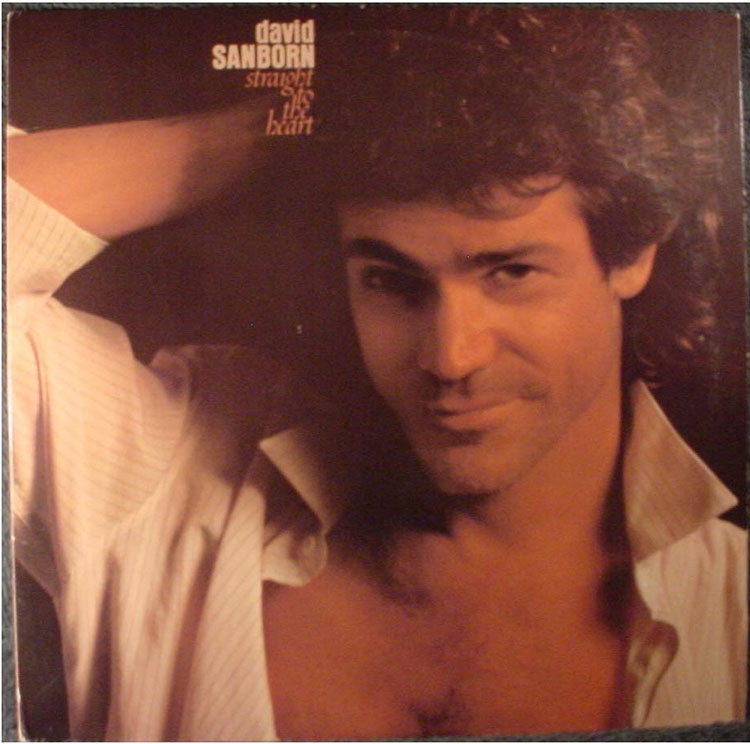
David Sanborn: Straight to the Heart CD
We recently received Michi’s new Q5 Transport/DAC for review, and as the Focal Diva Utopia system has a high-quality set of RCA inputs, adding one CD to the review list of music examples seemed proper. One might look at this Michi Q5 and declare that it is merely a CD player. This begs the question: Why is the moniker ‘Transport/DAC’ being applied? The answer is simple: Michi has made the Q5 a dedicated DAC with Toslink, Coaxial, and USB digital inputs, plus it has a separate CD transport built into the unit. Thus, this name is quite correct.
The Focal-Naim app made switching from the streaming service to the analog input for use with the Michi Q5 a snap, and over the last three weeks of the review, several CDs were auditioned with great success. “Straight to the Heart” is a worthy album of jazz that features David Sanborn’s alto saxophone, Marcus Miller’s bass guitar work, and Buddy Williams on drums.
Opening with “Hideaway,” The Trio of Williams, Miller, and Sanborn offer up an R&B vibe with tremendous energy from all three. Sanborn’s saxophone work has loads of bite to it, while Miller’s bass is inspiring. Halfway through this first track, David takes a break and lets Miller cut loose with a seriously fun duo with Williams on drum. The Focal towers made this into a “groove in your seat” performance, with some of the cleanest, tightest bass I have ever heard.
The title track slows things down with Sanborn’s saxophone whispering to the audience with a much more seductive tonal quality. The man also hits some deep notes with the sax that don’t seem possible. The Divas showed off their pacing talents on this track, with a style that felt almost analog in its overall feel. They are completely neutral yet feature a warmth that digital so often misses.
The rest of this fabulous live CD is more of the same. When bass is present, the Divas bring it all to life with authority. “Run for Cover” adds another driving bass line that melds into a strong brass crescendo featuring not only Sanborn but the trio of Michael Brecker on tenor sax, along with Randy Brecker and John Faddis on trumpet. It’s a fierce combination that requires a large-scale speaker, and again, the Focals just smile at the listener, bringing all the juice one could want. We now have over 200 hours of listening behind us, with the four selections for publication in this review representing only a portion of what we have heard in the last six weeks.
Measurements and analysis
The Focal Diva Utopia loudspeakers demonstrated such a high level of clarity in listening tests that I decided to run the long-term sine sweep on the Dayton Audio Omni Mic system, which will measure both the frequency response at the listening position and the THD generated by the speakers. The nominal SPL was set to 96 dB at our 11-foot distance from each loudspeaker. In layman’s terms, that is LOUD and a most difficult test for a speaker. Most THD measurements are taken with the microphone mere inches from the speaker, while this measurement was taken at over 20 times the usual distance.
The response curve (in room) measured at +/- 5 dB from 22.9 Hz to 10 kHz even at this high SPL. The bass is still strong enough to be effective to 20 Hz, where it hits the -10 dB level. This is an excellent response curve in-room and matches well with our listening tests. It will be a rare instance in which one will require a subwoofer with these speakers. The THD levels were also among the best we have measured here. THD peaked at 1.13 percent at 30.44 Hz, and from 40 Hz and up, it remained at 0.33 percent or lower. These measurements match up exceptionally well with the clear, almost ‘see through’ quality that the Diva Utopias delivered on both movie and music sources.
Secrets Sponsor
Focal’s Diva Utopias deliver flagship sound and premium looks from just two speaker cabinets, with no other components needed, for the mid-fi price of $40,000.
- 400 watts of pure Class AB power per speaker.
- Easy-to-use app.
- Full-range speaker with useful bass down to 20 Hz.
- Micro-dynamics are among the best one can find.
- Macro-dynamics that one can feel are almost without limit.
- Low distortion with neutral sound quality.
- Ease of physical placement with the excellent castors.
- Modern look that will fit in the most upscale domestic environment.
- Immersive sound stage with a 3D feel.
- Mini-monitor imaging.
- One doesn’t need to understand anything about audio systems to get great sound.
- A numbered volume control
Focal has created a new product category with its Diva Utopia. While active loudspeakers have been around for decades, Focal has taken the active speaker concept and fleshed it out into a complete system with a built-in Streamer, Analog and Digital inputs, Room Correction, and complete system integration with multiple online music sources. Focal and Naim have accomplished this while making it a system in which one can control volume, source, room correction, and other Naim products from a smartphone or tablet.
One can almost picture the meeting between Focal’s design team and Naim’s engineers. “Let’s take our Focal ‘W’ membrane speakers and design an integrated system. Let’s take the same drivers from a $40,000 pair of speakers but put them into a simpler cabinet. Then let’s add separate Naim amps for the ‘W’ woofer quad pack in each speaker, plus one for the ‘W’ 6.5-inch bass-midrange for each speaker AND another for the “M” profile Beryllium Tweeter. While we are at it, we are going to add a Naim streamer and a Naim DAC, and control it all from an app. We aren’t done yet. Let’s not charge $60,000 for putting all of this into one cabinet. No, let’s keep the price at $40,000 USD and make it accessible for more to get our sound in one easy-peasy package!”
There had to be some executives at the company who were wondering, “What were they thinking?” But, in the end, the executives decided to bring this to market for what ultimately is a bargain of an investment.
This is what Focal and Naim have done with the Focal Diva Utopia system. It is turnkey to the point that the largest deterrent in the audio world will be its simplicity in operation and in the buying decision. All the work has been done for you. We have all seen systems in which the cables alone can run more than the $40,000 price Focal is asking for the Diva Utopias. Utopia feels like the right name (Naim?) for these speakers because they do almost everything right, with no apparent weakness.
If I had a budget of $40,000 and wanted a total system, finding one that would beat this Diva would be a challenge. She’s a keeper!




